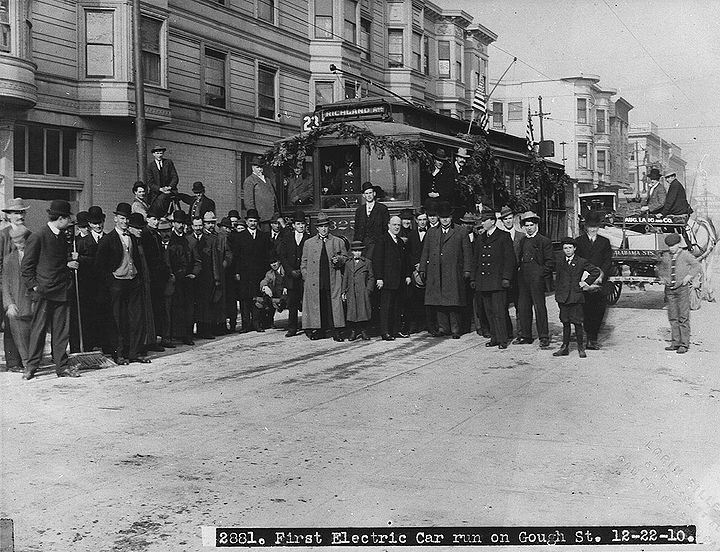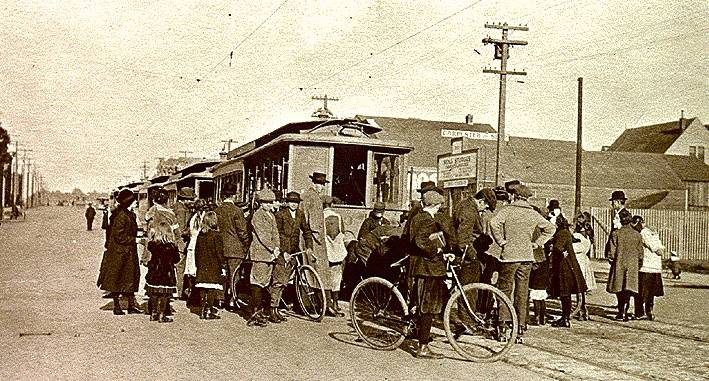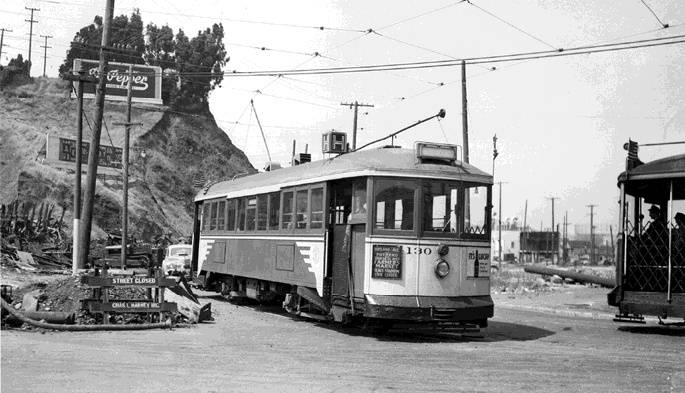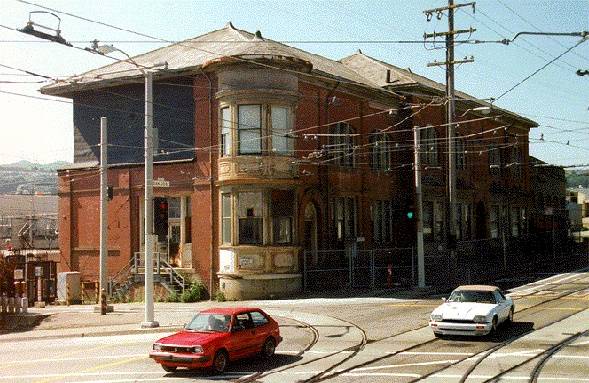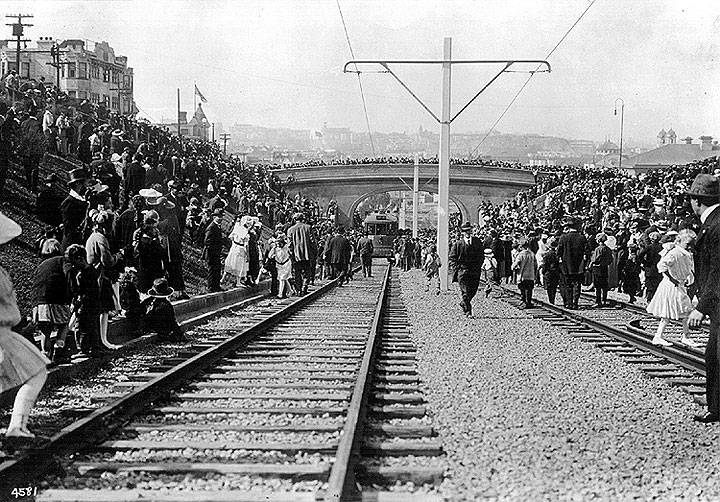MUNI History II: The Progressive Era and Public Development
Historical Essay
by Tom Matoff
First electric streetcar run on Gough Street, Dec. 22, 1910.
Photo: Charles Ruiz collection
Roots of Municipal ownership run deep in San Francisco, and the idea of public ownership of public utilities can be found from the middle of the 19th century. Only two decades after the sudden emergence of a world-famous metropolis, rising from a sudden tent city of miners, sailors and merchants, organized steps were being taken to Municipalize the water supply. However, for several decades, city government was very weak. Reacting to local political corruption and turmoil, the state had imposed the Consolidation Act in 1856, which created San Mateo County as a separate entity, consolidated city and county government in San Francisco, stripped the city of its charter, and significantly limited the powers of local government. William Issel and Robert Cherny in San Francisco 1865-1932 note that the Act granted "...few powers to the Board of Supervisors, made appropriating funds difficult, prohibited debts and liabilities, and reduced the mayor to little more than a presiding officer. ... (The) intent ...was to reduce city government to administration, with little potential for initiative." Control of the Port, of vital importance to the whole state, was taken away by additional legislation in 1860, not to be returned for more than a century, and even simple city functions such as street widenings could require an act of the legislature.
The new state constitution of 1879 provided that the city might enact a new charter and establish home rule. A twenty-year struggle began, culminating in final adoption of the charter of 1900. One is sometimes tempted to think of the charter of 1900 in the way that nostalgic Frenchmen, or American Francophiles, think of the Third Republic. This charter was the work of what Issel and Cherny characterize as businessmen reformers, who, under the leadership of James Phelan, wanted to see effective government at the local level; but it would be a mistake to think this meant it was a charter intended to hobble city government. To the contrary, the Progressives clearly wanted government to do things: Phelan's charter increased the authority of the mayor, dropped all semblance of a ward system in electing supervisors, and proposed eventual public ownership of utilities. In the reformers' view, Municipal government was to do far more than provide police and fire protection, education, and streets and sewers. Self-styled progressive citizens, the reformers hoped to use city government to provide direction for the very development of the city.
In this hope, there can be little doubt that they succeeded, for under the charter of 1900, San Francisco came back vigorously from destruction by earthquake and fire. Celebrating its rebirth and the Panama Canal in the spectacular Panama-Pacific International Exposition of 1915, constructed the Hetch-Hetchy water and power system, municipalized the Water Department, constructed the little-appreciated but vital high-pressure water supply network for firefighting, built the Civic Center and City Hall in large part from concepts in the Report on a Plan for San Francisco prepared by D. H. Burnham (who was also brought to San Francisco by Phelan ), and, very importantly, established and developed the Municipal Railway into one of the great transit systems of the country.
National as well as local political trends favored the establishment of a city-owned system, but three major factors also helped to discredit the United Railroads. First, the company was deeply implicated in the graft scandals which wracked the city in the first decade of the century; bribery was rampant, including significant sums exchanged for permission to electrify the Market Street cable lines after the earthquake. The level of corruption was astounding, even to modern readers. At one point, Abe Ruef, political boss of the Union Labor Party, in control of the mayor's office, was under contract to the legal staff of the United Railroads; the man who paid him, United's Chief Legal Counsel, Tirey Ford, was also simultaneously the state Attorney General. In the ensuing prosecutions, the United Railroads lost whatever public support it my have enjoyed. (The classic histories of this episode in the city's history are Walton Bean, Boss Ruef's San Francisco (1952), Lately Thomas, A Debonair Scoundrel (1962), and the biography of newspaper publisher Fremont Older by Evelyn Wells (1936), as well as Older's 1925 My Own Story; [even more recently, Philip Fradkin's The Great Earthquake and Firestorm of 1906 revises many of the previous histories incisively--c.c.]).
Second was the United Railroads strong anti-union policy, and its associated labor unrest. Strikes, or threats of strikes, permeated the atmosphere throughout this period. Transit workers were widely viewed as highly exploited, and labor leadership considered them as having worked under conditions of abject servility under a perfect system of espionage. A newly organized carmen's union won a strike in 1902, but in 1907 a major strike broke out, with the carmen's union demanding $3 for a ten-hour day. Professor Robert Knight in his important Industrial Relations in the San Francisco Bay Area 1900-1918 (1960) noted that: "It was the most violent streetcar strike ever seen in San Francisco, or probably in any other American city. The strike cost the United Railroads far more in revenue than had the devastation wrought by earthquake and fire the previous year." Strikebreakers were brought in by company President Patrick Calhoun, who was taking the fifth before the grand jury even as the strike got under way; there were riots, several deaths and numerous injuries. The company won the strike in the end, but a legacy of the strike was support for a public system. As an example of the level of passion reached in these circumstances, consider the comments of Muni Mayor James Rolph, who, when criticized by a company supporter for not providing the United Railroads adequate police support during yet another violent strike in late 1917 (the demand was for parity with Muni carmen) published an open letter including the following remarkable statement:
The world is changing all around you, and you and your kind don't know it any more than the Czar knew what was happening. ... Doubtless you are disappointed because the police have not yet turned machine guns on crowds in our streets, and killed a few dozen strikers, including the customary number of innocent bystanders.
Finally, the very wording of the charter, establishing public ownership as a matter of policy, tended to discourage further private investment and expansion of the private system. It seemed unlikely that private system expansion would or could provide adequate service to underserved parts of the city, in particular, areas such as the Sunset and Parkside, which would require expensive tunneling.
Of the three remaining independent systems, the Geary Street, Park and Ocean Railroad and the Presidio and Ferries Railroad were facing early franchise expirations. The city decided to move first for the Geary line, which had heavy ridership, reached the heart of the business district, and enjoyed direct access to the Richmond District, ripe for development. After three unsuccessful efforts at the polls, a bond issue was passed in December 1909 providing the funds to rebuild the Geary line into a modern, publicly-owned electric streetcar line. Court challenges occupied much of 1910, but the city persevered, and construction began in June 1911. On May 5, 1912, the Geary cable line ran its last mile, and major construction began in earnest. Despite some difficulties with and delays from W. L. Holman, the local car builder, requiring the attention of the Mayor's office (some things never seem to change), enough cars were delivered, and construction was sufficiently complete to permit the Geary line to open on December 30, 1912. Newly-elected Mayor James "Sunny Jim" Rolph rode the first car. His speech to the large crowd outlined his transit policy, largely followed during his 19 years in office:
"It is in reality the people's road, built by the people and with the people's money. The first cable road in the country was built in San Francisco, and now the first Municipal railway of the country is built in San Francisco. Our operation of this road will be closely watched by the whole country. It must prove a success! We must run it by proper methods. When we have built from the Ferry to the Ocean, it will be the best single route in the city, and we must extend it wherever possible, until it becomes a great Municipal system. I want everyone to feel that it is but the nucleus of a mighty system of streetcar lines which will one day encompass the entire city."
Last of the cable cars into the Richmond District. This photo, taken on Geary St. at 4th Avenue in April, 1912 of the cable cars that ran on Geary from Arguello to 5th Avenue, then south to Fulton St. and west to 12th Avenue. The wires are already strung for the new Municipal Rail line that would be "opened" with Mayor Rolph operating the first car, December 28, 1912. Full service on the Muni A line would not start until May, 1913 and traveled from Market Street, west on Geary to 10th Avenue and Fulton St.
Photo: Private Collection, San Francisco, CA
Of the ten cars placed in service that day, one car, Muni's own Car No. 1, remains in existence, and, fully restored, operates on special occasions and charters. Few are the cities anywhere in the world which can claim to have in operating condition their own original streetcar, home-built, laden with the honor of many years of public service!
Another important individual had also taken office in 1912: City Engineer M. M. O'Shaughnessy. He became Rolph's indispensable technical factotum, and guided the city's engineering staff during the great constructive period of public works that coincided with the Rolph administration. And even in that era, there was a consultant, Bion J. Arnold of Chicago, a pre-eminent consulting engineer of this era. Arnold's Report on the Improvement and Development of the Transportation Facilities of San Francisco, published in 1913, was a detailed, in-depth analysis of transit operations and needs throughout the city. In a very real sense, Arnold's report was a detailing of the transit and subway system called for in the Burnham Plan of 1906, as was pointed out by James R. McCarthy, 1960s' City Planning Director, in his introduction to the Burnham Plan reprint of 1971. The Report laid the groundwork for the mighty system which Rolph and O'Shaughnessy developed in the years leading up to the Great Depression. In its ambitious, comprehensive approach, and appreciation for the commercial aspects of the operation as well as its engineering and city planning features, Arnold's great work set a standard that consultants should try to emulate even today. It is also beautifully written, in actual English, of which the following passage is typical:
...the city has been greatly handicapped in its proper development by the lack of appreciation of the problems of the future, as well as lax Municipal control, and failure of the utilities to keep pace with the city's rapid growth in the past. This especially concerns transportation, which must precede settlement. While the climatic conditions are ideal, the rugged topography has resulted in isolation of local districts, which absolutely requires the construction of tunnels and the execution of a City Plan that will correct present obvious errors by means of wider streets and contour subdivision of property. Only by thus welding together these districts will it be possible to conserve the unusual liberality of its citizens, as exhibited in the high street railway earnings per capita, for the prime objects of civic expansion, with one city, one fare, universal transfers, centralized operation, minimum investment, and finally Municipal ownership if the city's present policy continues to prevail.
The Geary service was a great and immediate success. By August 1913, the city placed before the voters another bond issue to build more of the system outlined in the Arnold Report, and detailed by City Engineer O'Shaughnessy and staff. A matter of special concern was the pressing need for transit facilities to the Harbor View district (today known as The Marina) where the Panama-Pacific International Exposition was to be held. Indeed, the opening day was only eighteen months away. The issue was approved by a wide margin and the city sprang into action, acquiring the next-to-last independent company, the Presidio and Ferries Railroad, whose Union Street line was one of the key potential routes to the exposition site. Despite the short time available, progress was made at a pace impossible to replicate today. By the Spring of 1915, Muni had new lines in operation on Van Ness and Potrero Avenues, Union Street, Stockton Street, and the Richmond District segment of California Street, as well as the streetcars necessary to operate them, and a second new carbarn at 17th Street to complement the original facility at Presidio and Geary. (Both are still in use today for trolleybuses).
H-Line streetcar on San Bruno below Bernal Heights, 1930s (this site is now beneath Hwy 101)
Photo: Private Collection, San Francisco, CA
The old Geneva carbarn at San Jose and Geneva, one of several sites owned by United Railroads and used to house strikebreakers during the 1917 strike. During that strike the SF Board of Supervisors voted to lay two outside tracks along Market Street, providing the first publicly owned rails all the way in to the center of the city.
Photo: Chris Carlsson
<iframe src="https://archive.org/embed/ssfCARSTRIK" width="640" height="480" frameborder="0" webkitallowfullscreen="true" mozallowfullscreen="true" allowfullscreen></iframe>
1917 strike violence on Haight and Buchanan.
Video: Prelinger Archive
After a period of extended legal skirmishes with the United Railroads, Muni's own streetcars had managed to reach the Ferry Building, an important source of business, and a major regional destination for San Franciscans and suburbanites alike. Two additional outer streetcar tracks were added to the United Railroads existing pair, so that Market Street joined the exclusive ranks of four-tracked streets. More lines followed: the J-Church, with its scenic alignment through Dolores Park and nearby backyards, opened in 1917, bringing Municipal competition to Noe Valley.
J-Church opening being celebrated in 1917.
Photo: Private Collection, San Francisco, CA
The Twin Peaks Tunnel, America's longest streetcar tunnel, and an important engineering achievement, also opened in 1917. Three Twin Peaks lines familiar to us today, serving Ocean Avenue (the K-Ingleside), Taraval Street (the L), and 19th Avenue (the M-Ocean View) date from this period, as did the beginnings of bus operation. The height of transit development under this system was reached just before the onset of the Depression. In 1928, Muni opened its last entirely new streetcar line, the N-Judah, which required its own Sunset Tunnel. In old photos of these many, happy opening days, there is no happier face than that of Mayor Rolph, who personally presided over many of these events. Rolph supplied the political leadership to develop the system, and Muni's popularity, so at odds with today's perceptions, helped his political fortunes. In 1930 Rolph was elected Governor.
The Roar of the Four typifies this era. Take any sample of San Francisco picture postcards from the 1915-1945 era, and among them will probably be a shot of Market Street with four tracks full of streetcars, and sidewalks full of people. This, like Broadway in Manhattan, or State Street in Chicago, was classic urban America at its Jazz Age height. San Francisco was as busy and noisy an urban attraction as any on earth, and transit -- lots of transit -- was its very essence. As our own Sackamenna Kid later wrote, describing an evening arrival in the city by ferry after a trip down from the capital on his favored Sacramento Northern Railway:
To a raw kid from the Sacramento Valley this was part of the magic of coming to San Francisco across a dark Bay whose waters suddenly began to glow in reflected glory. Adventures marvelous to relate lay just beyond those gleaming lights, just beyond the loop where the endless streetcars rattled, squeaked and clanged their metropolitan music ... Maybe its true that you have to be born elsewhere to appreciate San Francisco to the full (or overflowing). Not that I'm going to put the knock on Sacramento, which has a couple of modest skyscrapers of its own and a Lower End (the Sacramento term for Skid Road) every bit as seamy and battle scarred as San Francisco's ... But Sacramento is a river town, a valley town, and its pace is inevitably slower. Even as a kid I noticed that its streetcars were smaller and less noisy than San Francisco's, and they meandered along in a dream (and there was hardly anything to clang the bell at, except maybe a stray dog) ... Parks, trees and lawns are all very fine, but it was the din of the big city that fascinated me, and Market St., roaring out from the Ferry Building on four streetcar tracks, was definitely the noisiest main street in the world. And, 'We're going to San Francisco' was the most exciting cry a Sacramento boy could hear.
--Herb Caen, A Backward Glance February 26, 1961
--Excerpted from The Muni Paradox--A Brief Social History of the Municipal Railway by Tom Matoff, LTK Engineering Services, published in the June 1999 issue of the SPUR newsletter

